Response Analysis And Vibroinsulation Of Buildings Subject To Technical Seismicity
Price
Free (open access)
Transaction
Volume
104
Pages
9
Page Range
197 - 205
Published
2009
Size
3,037 kb
Paper DOI
10.2495/ERES090181
Copyright
WIT Press
Author(s)
D. Makovička & D. Makovička Jr.
Abstract
Building structures in the vicinity of transport lines are loaded by vibrations excited by the passage of motor vehicles or trains. These vibrations propagate as technical seismicity effects through the soil to the foundations of buildings in the vicinity of their source. Due to its tuning, the building structure usually amplifies or, in better cases, reduces the effects of technical seismicity. An effective method for reducing the vibration level of the protected structure as a whole with reference to its foundation structures (plate, piles, strips, etc.) is to spring it from the foundations. This springing is usually effected by placing the whole upper part of the structure on individual springs or sprung layers. The effectiveness of the springing is determined by the frequency tuning of the sprung structure. This paper deals with the application of an elastic antivibration layer at the foundation base level in order to eliminate excessive vibrations propagating to the assessed building through the geological environment as technical seismicity. Keywords: building structure, transport effects, vibroprotection, dynamic response. 1 Introduction The dynamic effects of subsurface traffic propagating through the ground environment into the ambient buildings of urban agglomerations have been acquiring ever-increasing importance. Construction firms make efforts to exploit areas in the proximity of underground lines because of their lucrative location, usually for residential construction. In the proximity of underground tunnels or
Keywords
building structure, transport effects, vibroprotection, dynamic response.





